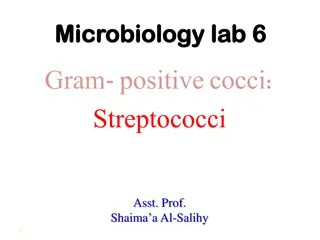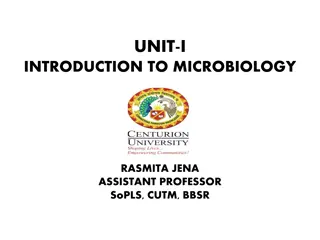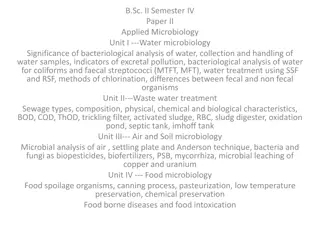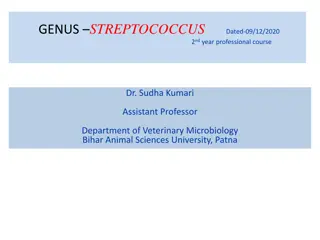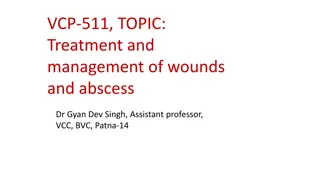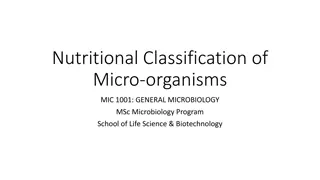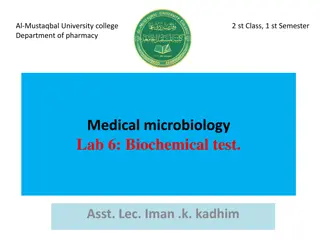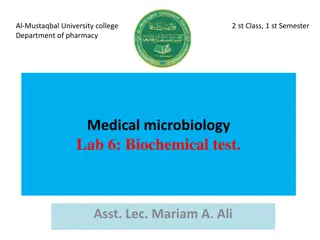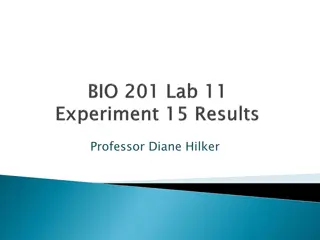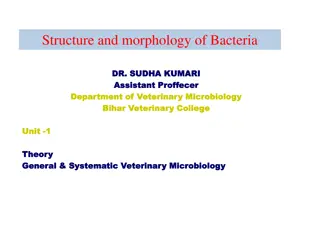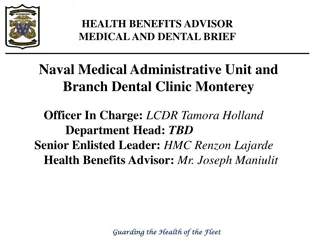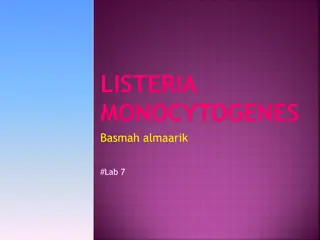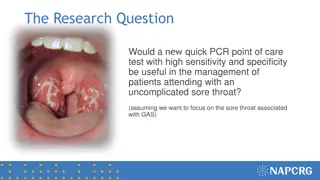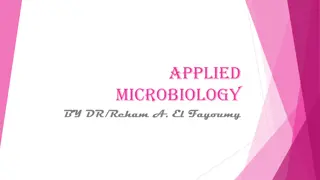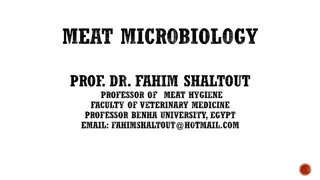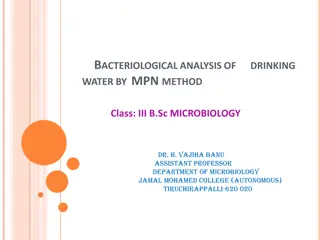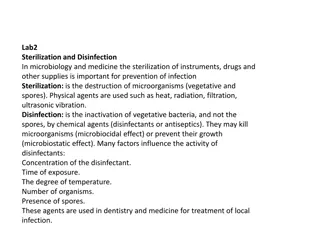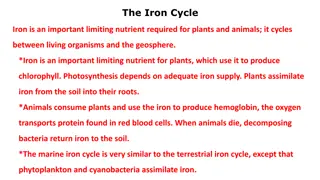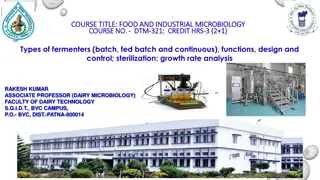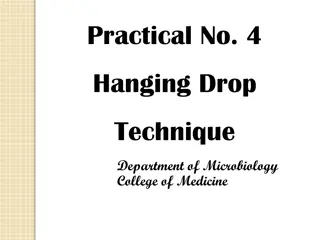Overview of Streptococci and Their Classification in Medical Microbiology
Streptococci are diverse Gram-positive bacteria found in nature, some of which are part of the human microbiota while others cause diseases. This article discusses the morphology, classification, hemolysis properties, Lancefield grouping, and details about Streptococcus pyogenes, a significant human pathogen.
Download Presentation

Please find below an Image/Link to download the presentation.
The content on the website is provided AS IS for your information and personal use only. It may not be sold, licensed, or shared on other websites without obtaining consent from the author. Download presentation by click this link. If you encounter any issues during the download, it is possible that the publisher has removed the file from their server.
E N D
Presentation Transcript
Vandana gupta Medical Microbiology SemVI
The Streptococci The streptococci are large and heterogenous group of Gram positive spherical bacteria that characteristically form pairs or chains during growth. They are widely distributed in nature, some are members of normal human microflora. Some are associated with important human diseases
Classification of Streptococci Streptococci classification based on a series of observations like: A- Colony morphology and hemolytic reactions on blood agar. B- Serologic specificity of cell wall group- specific substance or capsular antigens. C- Biochemical reactions and resistance to physical and chemical factors
HEMOLYSIS Many streptococci are able to hemolyze red blood cells in vitro in varying degrees.Based on this 3 different categories are-: Beta hemolysis : Complete disruption of erythrocytes with clearing of blood around the bacterial growth. Eg. S.pyogenes . alfa hemolysis : Incomplete hemolysis of erythrocytes with reduction of hemoglobin and the formation of green pigment.Also called viridans group. Eg. S.pneumoniae. gamma hemolytic : No zone is formed during hemolysis.Mostly saprophytes. Eg. S.bovis .
http://biology.clc.uc.edu/fankhauser/labs/microbiology/strep_detection/hemolysis_P8040099lbd.JPGhttp://biology.clc.uc.edu/fankhauser/labs/microbiology/strep_detection/hemolysis_P8040099lbd.JPG Hemolysis
Group specific substance (Lancefield classification) This carbohydrate is contained in the cell wall of many streptococci and forms the basis of serologic grouping into Lancefield groups A-H and K-U. The serologic specificity of group-specific carbohydrate is determined by an amino sugar.
http://t3.gstatic.com/images?q=tbn:ANd9GcSYpsQzFZ7_Hrp_tLkHB0Ke_-3H4uwb4Y2EDLpvu22Z97S0Y5kihttp://t3.gstatic.com/images?q=tbn:ANd9GcSYpsQzFZ7_Hrp_tLkHB0Ke_-3H4uwb4Y2EDLpvu22Z97S0Y5ki
Streptococcus pyogenes Most streptococci that contain the group A antigen are S.pyogenes. It is the main human pathogen associated with local or systemic invasion and post streptococcal immunologic disorders. It produces large (1 cm in diameter)zones of B -hemolysis
S. pyogenes typically colonizes the throat, genital mucosa, rectum, and skin. Of healthy individuals, 1% to 5% have throat, vaginal, or rectal carriage. In healthy children, such carriage rate varies from 2% to 17%. Transmission Inhalation of respiratory droplets, skin contact, contact with objects, surface, or dust that is contaminated with bacteria
TOXINS and ENZYMES Streptokinase: It is produced by many strains of group A (Beta hemolytic) streptococci. It transform the plaminogen of human plasma into plasmin, an active proteolytic enzyme that digests fibrin and other proteins. Hyaluronidase : It splits hyaluronic acid, an important component of the ground substance of connective tissue and aids in spreading. Pyrogenic Exotoxins A,B and C. associated with streptococcal toxic shock syndrome and scarlet fever. pyrogenic toxins acts as superantigens, which stimulate T cells by binding to class II MHC. The activated T cells release cytokines that mediate shock and tissue injury. 1. 2. 3.
capsules composed of hyaluronic acid: role in virulence: antiphagocytic. Pili of group A streptococci: consists partly of M protein and are covered with Lipoteichoic acid: important in attachment of streptococci to epithelial cells. Most streptococci are facultative anaerobes and grow under aerobic and anaerobic conditions. Peptostreptococci are obligate anaerobes.
Hemolysins Streptolysin S A cardiotoxic exotoxin, another beta- hemolytic component, not immunogenic O2stable: A potent cell poison affecting many types of cell eg neutrophils, platelets, and subcellular organelles. Streptolysin O. An exotoxin, one of the bases of the beta-hemolytic property, causes an immune response and detection of antibodies to it; antistreptolysin O (ASO) can be clinically used to confirm a recent infection. It is damaged by oxygen.
Acute manifestations of S.p. infections 1. Impetigo : localized skin infection 2. Erysipelas : If the portal of entry is skin, erysipelas results with massive brawny edema and a rapidly advancing margin of infection. 3. Erysipelas and cellulitis are characterized by multiplication and lateral spread of S. pyogenes in deep layers of the skin. 4. Invasion and multiplication in the fascia can lead to necrotizing fasciitis, a life-threatening condition requiring surgery (Flesh eating bacteria). 5. Neonatal infections
2. SOFT TISSUE INECTIONS 1. Puerperal fever : Infection of uterus after delivery- puerperal fever, which is a septicemia originating in the infected wound (endometritis). 2. Sore throat : -The most common infection due to B-hemolytic S. pyogenes-- streptococcal sore throat or pharyngitis. S. pyogenes adhere to the pharyngeal epithelium by means of Lipotechoic acid- covered surface pili and also by means of hyaluronic acid in encapsulated strains. The illness may persist for weeks and characterized by nasopharyngitis, tonsilitis, erythema and edema of mucus membranes.
Sore Throat cellulitis http://t1.gstatic.com/images?q=tbn:ANd9GcSWd1ASzobUAjI7dVVp9z0bbtdCzAQw6tcvy7RETyrD6uI3_Bur Scarlet ever Erysipelas Impetido
4. Toxic shock syndrome It is characterized by shock ,bacterimia, respiratory failure and multiorgan failure. Death occurs in about 30% of patients. Erythema and desquamation may occur. Scarlet fever Pyrogenic exotoxins A-C also cause scarlet fever in asociation with S.pyogenes pharyngitis or with skin or soft tissue infection. 5.
Chronic manifestations Rheumatic fever : Most serious : results in damage to heart muscle and valves. Certain strains of group A streptococci contain cell membrane antigens that cross react with human heart tissue antigens. Hence autoimmune reaction Symptoms include fever, malaise, a migratory non- suppurative polyarthritis and evidence of inflammation of all parts of heart and/or joints following an episode of streptococcal pharyngitis The first attack produces only slight damage but increases with each subsequent attack. acute post-infectious glomerulonephritis. Acute glomerulonephritis, inflammation of the renal glomerulus, can follow streptococcal pharyngitis or skin infection.
Diagnosis Smears : pus smears show single cocci or pairs rather than definite chains. cocci are sometime Gram negative because the organism are no longer viable and have lost their ability to retain crystal violet. Specimens : may be obtained from throat swab, pus or blood. Serum is obtained for antibody determination. Culture : on blood agar plates. If anaerobes are suspected, suitable anaerobic media must also be inoculated. Incubation in 10% CO2 speeds hemolysis . Antigen Detection Test: kits use enzymatic or chemical methods to extract the antigen from swab and use agglutination test to confirm the presence.
http://t0.gstatic.com/images?q=tbn:ANd9GcQWGYjsXkIpFEisnZVwL2ixc8qwD5LFYPYLi_Z-xxFQAfjyzXYhttp://t0.gstatic.com/images?q=tbn:ANd9GcQWGYjsXkIpFEisnZVwL2ixc8qwD5LFYPYLi_Z-xxFQAfjyzXY Treatment All S.pyogenes are susceptible to Penicillin G and most are susceptible to erythromycin. Some are resistant to tetracycline. Antimicrobial drugs are very useful in preventing reinfection with B hemolysis group A streptococci in rheumatic fever patients. In acute infections,every effort must be made to rapidly eradicate streptococci from patients. http://t0.gstatic.com/images?q=tbn:ANd9GcREhXayxkZUbwhqEBhYAryn6kYCjlUR9YxGs1uPVfoC7PRS2bBwJg
Prevention & Control Detection and early antimicrobial therapy of respiratory and skin infections with group A streptococci to prevent development of post streptococcal disease. chemoprophylaxis for rheumatic fever includes injection of benzathine Penicillin intramuscularly or oral penicillin or sulfonamide. Eradication of S.pyogenes from carriers espcially from areas like delivery rooms,operating rooms,or nurseries.


